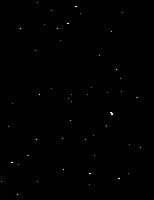|
|
 |
|
How It All Began
Our Solar System was created when a nebula, made up of mostly hydrogen, gradually collapsed and formed a spinning protostar.
Gravitational contraction heated the protostar and a nuclear fission reaction was sparked in the hot, dense gas that condenced
at its center. Our Sun was born. The planets were formed from the remaining disc of material still swirling around our new-born
Sun. The largest four of our planets were composed of mainly hydrogen as well as helium. They and the Sun are relics of protostellar
material that existed 4.6 billion years ago. The impurities went to form the terrestrial planets.
Introduction to the Solar System
Since mankind arose, people have looked to the stars, believing them to be Gods. Some called them the 'Wanderers', and invested
a complex mythology in them. Many cultures worshipped them through song, praise, prayer and even ritual sacrifice. For thousands
of years people thought the planets, moons and Sun revolved around the Earth, and that the Earth was the center of the universe.
When telescopes were invented in the seventeenth century, people began to think that the Earth wasn't the center of the universe,
and that the planets did not revolve around the Earth, but rather the Sun. This concept was called heliocentrism. People started
thinking of the planets as worlds very much like our own, and not the mythological Gods people thought they were. People started
to think that other civilisations existed on other planets. As telescopes were improved, more planets were found. Uranus,
Neptune and Pluto. There may even be other planets beyond Pluto, but only time will solve the answer to that question.
How It All Began and Introduction to the Solar System: http://evula.org/solarsystem/
Author Unknown
|
 |
|
THE SUN
The Sun is the most prominent feature in our solar system. It is the largest object and contains approximately 98% of
the total solar system mass. One hundred and nine Earths would be required to fit across the Sun's disk, and its interior
could hold over 1.3 million Earths. The Sun's outer visible layer is called the photosphere and has a temperature of 6,000°C
(11,000°F). This layer has a mottled appearance due to the turbulent eruptions of energy at the surface. Solar energy is
created deep within the core of the Sun. It is here that the temperature (15,000,000° C; 27,000,000° F) and pressure (340
billion times Earth's air pressure at sea level) is so intense that nuclear reactions take place. This reaction causes four
protons or hydrogen nuclei to fuse together to form one alpha particle or helium nucleus. Energy generated in the Sun's core
takes a million years to reach its surface. Every second 700 million tons of hydrogen are converted into helium ashes. In
the process 5 million tons of pure energy is released; therefore, as time goes on the Sun is becoming lighter.
MARS
Because of its blood-red color (which comes from iron-rich dust), this planet was named for Mars, the Roman god of war.
Mars is the fourth planet from the Sun, situated between Earth and Jupiter. Three-quarters red, Mars also has dark blotches
on it and white areas at the poles; these are white polar ice caps.
JUPITER
Jupiter, the largest planet in our solar system, was named for the most important Roman god because of its size. About
1,300 Earths would fit into it. Viewed through a large telescope, Jupiter is stunningly colorful;it is a disk covered with
bands of blue, brown, pink, red, orange, and yellow. Its most distinguishing feature is; the Great Red Spot, an intense windstorm
larger in size than Earth, which has continued for centuries without any signs of dying down.
SATURN
Saturn, the second-largest planet, has majestic rings surrounding it. Named for the Roman god of farming, Saturn was the
farthest planet known by the ancients. Saturn's seven rings are flat and lie inside one another. They are made of billions
of ice particles.
PLUTO
Pluto, named after the Roman and Greek god of the underworld, is the coldest, smallest, and outermost planet in our solar
system. Pluto and its moon, Charon, are called double planets because Charon is so large it seems less of a moon than another
planet. Pluto was predicted to exist in 1905 and discovered in 1930. It is the only planet that has not yet been studied closely
by a space probe.
An Interesting Program
Celestia is an interesting program that let you travel through the universe and explore all the planets and stars. If you
ever looked upon the sky at night dreaming of flying through space visiting all those bright shining stars and planets you
will love them! Celestia is a real time program, that means that you can view all the planets and stars move along their paths,
trace them and orbit them. With Celestia you can go on a space travel and explore our universe. When you start the program
you will first see Jupiter's moon Io. The voyage can begin. But when you run the program for the first time you should first
make a guided tour and go on a demo flight by pressing d-key. You will leave Earth and see some very nice pictures of our
blue planet. Next is the moon, followed by pictures of the sun. Now you see the planets on their orbits. After this you travel
to see Saturn, some star constellations and the milky way before going home again.
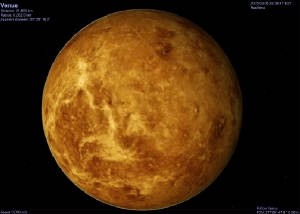
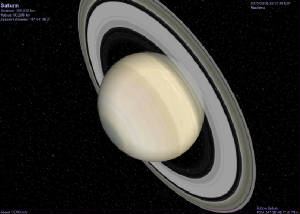
|
 |
|
|
|
 |
|
MERCURY
Mercury, the planet closest to the Sun, has almost no atmosphere, and its dusty surface of craters resembles the Moon.
The planet was named for the Roman god Mercury, a winged messenger, and it travels around the Sun faster than any other planet.
Mercury is difficult to see from Earth in fact, the famous astronomer Nicolaus Copernicus, for all his years of research and
observation, never once was able to see Mercury.
VENUS
Venus is often called Earth's twin because the two planets are close in size, but that's the only similarity. The thick
clouds that cover Venus create a greenhouse effect that keeps it sizzling at 864°F. Venus, named after the Roman goddess of
love and beauty, is also known as the morning star and evening star since it is visible at these times to the unaided eye.
Venus appears as a bright, white disk from Earth.
EARTH
From the perspective we get on Earth, our planet appears to be big and sturdy with an endless ocean of air. From space,
astronauts often get the impression that the Earth is small with a thin, fragile layer of atmosphere. For a space traveler,
the distinguishing Earth features are the blue waters, brown and green land masses and white clouds set against a black background.
URANUS
Uranus is a greenish-blue planet, twice as far from the Sun as its neighbor Saturn. Uranus wasn't discovered until 1781.
Its discoveror, William Herschel, named it Georgium Sidus (the Georgian star) after the English king, George III. Later its
name was changed to Uranus, after an ancient Greek sky god, since all the other planets had been named after Roman and Greek
gods.
NEPTUNE
Neptune, named for an ancient Roman sea god, is a stormy blue planet about 30 times farther from the Sun than Earth. Neptune
was discovered when astronomers realized that something was exerting a gravitational pull on Uranus, and that it was possible
that an unknown planet might be responsible. Through mathematical calculations, astronomers determined there was indeed an
undiscovered planet out in space a year before it was actually seen for the first time through a telescope (in 1846).
Articles and Pictures from:
http://www.factmonster.com/ipka/A0769141.html
Author Unknown
Distances From the Sun
In Miles
 |
 |
|
Mercury
|
36 Million
|
|
Venus
|
67 Million
|
|
Earth
|
93 Million
|
|
Mars
|
141 Million
|
|
Jupiter
|
483 Million
|
|
Saturn
|
886 Million
|
|
Uranus
|
1.78 Billion
|
|
Neptune
|
2.79 Billion
|
|
Pluto
|
3.67 Billion
|
|
 |
 |
A Few Features of Celestia
Tours -- In Celestia you can set up a self created tour. By simply choosing the planets or stars that you would like to see
in any certain order, you are transported at incredible speeds throughout the universe.
Real Time -- As you watch a particular planet or star the rest of the model is moving in real time. In other words the
celestial objects including the one you are watching are moving in their true-life paths throughout the universe. This can
be speeded up to watch orbits and rotations.
Zoom In/Out -- The object you are watching can be viewed in a broad view many kilometers away from the surface or by rolling
the scroll wheel on your mouse you can zoom in all the way to the surface if you like.
Constellations -- The program demonstrates and illustrates the constellations and their movements through space. The
stars are connected by thin lines and they are labeled.
http://www.tldp.org/linuxfocus/English/Archives/lf-2002_05-0244.pdf
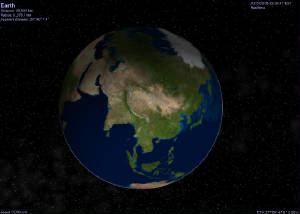
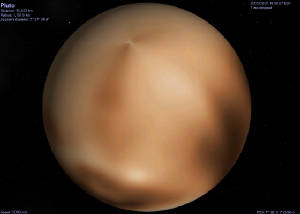
|
 |
|
|
|
|
|
|
|
 |
